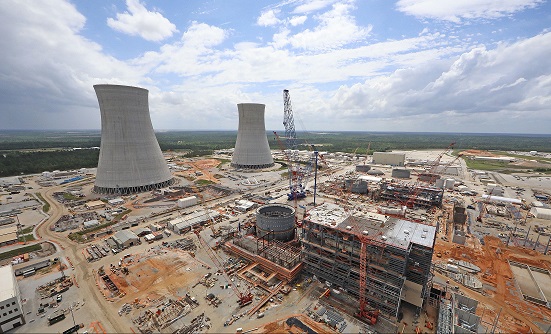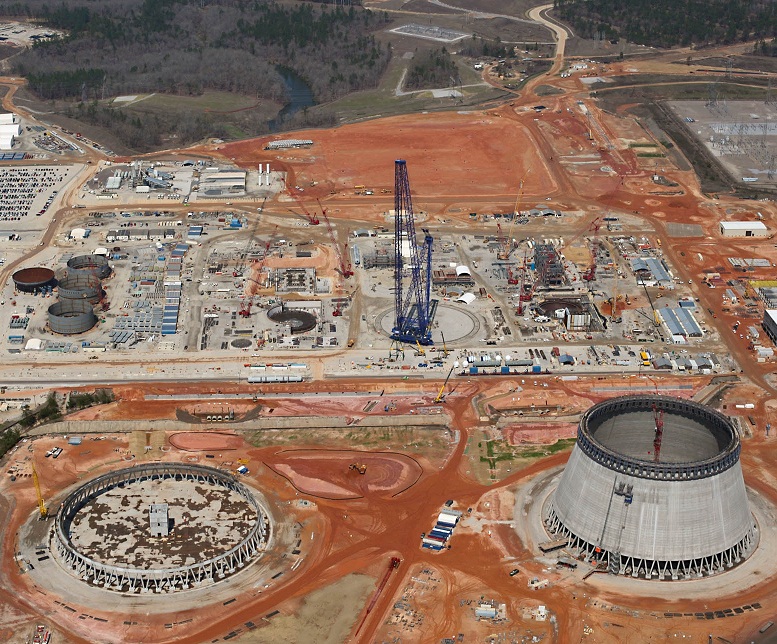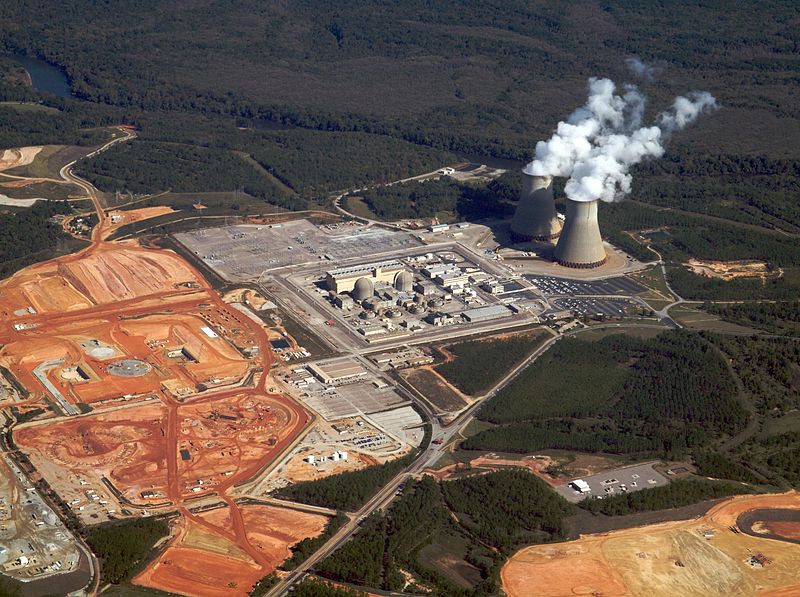Homeowners are lucky if they get a 60 day rate lock on their mortgage application. Nuclear reactor developers seem to have no such problem: agreements for multi-billion dollar subsidized loans to build two new nuclear reactors at Plant Vogtle in Georgia have been repeatedly extended for four years.[fn]While the Vogtle credits are commonly referred to as loan guarantees, they are actually direct loans since the originator is the Federal Financing Bank, an affiliate of the US Treasury.[/fn] A credit market meltdown didn't stop the extensions. Nor did the rise of fracked gas and a recession, both undercutting nuclear plant economics. Nor did the cancellation of one nuclear project after another, and large cost-overruns at those projects still being pursued. Every six months or so, the required date of execution would simply be extended, offering a free option contract to project participants.
Today a smiling Ernest Moniz, Secretary of the US Department of Energy, will be heading to Georgia for the signing ceremony as these loan agreements are finally executed. He will likely talk about how this is the type of partnership that makes America strong; how the loans are the result of hard work by so many, and all should be proud; and how the US wants to buy and build every form of energy because, well, that's what we need to do.
What ultimately got this agreement to "yes" is not likely something any of the parties will discuss in their prepared remarks. Perhaps it was because DOE finally got a backbone and refused to extend the original agreement any further. Maybe the borrowers were getting pressure from shareholders to offload the risk, or because interest rates are creeping up and Southern Company (the parent co. of Georgia Power, the largest partner in the Vogtle consortium) won't be able to roll its short-term financing for next to nothing.
We'll likely never know the truth. But regardless of the drivers, the completion of the loan guarantee agreement is really quite a shame. It puts a tremendous amount of risk on taxpayers and gives nothing in return. Southern Company's CEO Tom Fanning said they didn't need the public funds, could finance the project privately, and would still build the reactors without the federal guarantee. So when DOE's press release notes that "[t]he nuclear facility is eligible for loan guarantees since it is expected to avoid nearly 10 million metric tons of carbon dioxide emissions annually, which is the equivalent of removing more than two million vehicles from the roads," the statement of eligibility is technically correct. But the connection between the loan and CO2 reductions is specious given that even the borrower says the project would have been built anyway; there are many ways to reduce carbon; and our public policy ought to be competing options against each other to buy the lowest-cost reductions first. South Carolina Electric & Gas is privately financing its construction of two reactors, after all. Surely the Vogtle team could have done the same.
And Fanning had complained he didn't like changes DOE had made to loan terms: "Those terms and conditions just aren't suitable for our application, so we'll just have to see." Did DOE cave and sweeten the terms (most likely by reducing the credit subsidy payment below it's already too-low level), putting taxpayers at even greater financial risk? Or did the Vogtle investors realize the terms really weren't so bad after all as they saw Wall Street steering well clear of nuclear new build? Though these are the details that drive taxpayer risk, subsidy magnitude, and competitive distortions across different energy options, it is safe to assume that this area, as well, won't get broached by the smiling faces at the signing. Nor, absent yet more litigation to force disclosure, will DOE likely reveal them at all.
Our review of the thousands of pages of internal documents related to DOE's loans to Vogtle that were forced out by litigation (see above link) clearly indicated a messy process with decisions driven by well more than just deal economics and proper financial risk management. The resulting agreement is no case study in good oversight or democracy. And yet the result is taxpayer funding equal to 15 Solyndras and 43 Fiskers (an electric car marker that also went bust owing DOE money). If things go wrong on Vogtle, taxpayer losses on Solyndra and Fisker will be mere footnotes in comparison.
Looking in the crystal ball: what Fisker's bankruptcy can tell us about Vogtle
My colleague Ron Steenblik of OECD recently linked to an article on how Chinese autoparts giant Wianxing just won its bid for the bankrupt assets of DOE-funded electric carmaker Fisker Automotive. This same firm also bought the distressed assets of DOE-funded battery maker A123 (cleverly renamed B456). Reporter Katie Fehrenbacher notes that
As with Wanxiang’s deal with A123, controversy will follow the realization that a Chinese conglomerate will likely be taking over an electric car maker that got substantial funding from the U.S. government.
And yet, should this be the point of controversy? If DOE is going to play the Big League Venture Capitalist game (Secretary Moniz has restated they will), this type of occurrence is part of the drill. Early money gets diluted in new investment rounds when things aren't going well (as they often don't). Original equity holders get wiped out, and debt holders may as well when the firm goes bankrupt. Getting something back is still better than losing everything.
DOE's only leverage point here was at the beginning ("to lend, or not to lend, that is the question"). People ought not be surprised that the corporate carcass is sold on the cheap post-default or during a pre-packaged bankruptcy.
In private markets, venture capitalists line up to play this game because enough of their portfolio companies break even or nearly so to stem losses; and, far more importantly, every once in awhile they get back 100x or more with a blockbuster new company such as Google or Facebook. Even a handful of home runs can offset the losers with enough left over for them to buy a summer place in the Hamptons.
Alas, when governments are the investor, this upside disappears. The government deals, including for Vogtle, are structured to extend huge chunks of debt to borrowers -- often far more than a private lender would extend given the project risks. And yet, taxpayers get no equity at all: even if a project receiving $500m or $8.3 billion in taxpayer support is wildly successful, generating Google-like returns, taxpayers still get squat. In a private firm, the partners who decide which firms to fund do well when the firms they've funded do well; if their investments tank, so does their pay. In public progams such as the Vogtle mega-loan, public dealmakers have no financial tie to how their decisions play out over time; indeed, they have often moved on by then. Socialized risks, privatized profits is the model that the Vogtle deal seems to have followed to the letter.
The Chinese buyouts of US government-funded firms on the cheap have stirred anger. But second movers often get the benefit of buying up the residuals of first-mover firms that have failed. Perhaps we ought not get too teary-eyed about the misplaced $192 million loan to Fisker given that the Vogtle loan puts more than 40x as much taxpayer capital at risk. The nukes industry has repeatedly said there is nothing to worry about. These are good projects (though not so good, of course, that they just build them with private money), and won't go bust, they repeat again and again. So we can rest easy -- just like ratepayers facing a $1.5 billion loss from Duke Energy's recent cancellation of the Levy nuclear project in Florida. They weren't supposed to lose money either.






 credit risk estimates were systematically blocked as well), there was nonetheless quite a bit there. You can read the full study
credit risk estimates were systematically blocked as well), there was nonetheless quite a bit there. You can read the full study